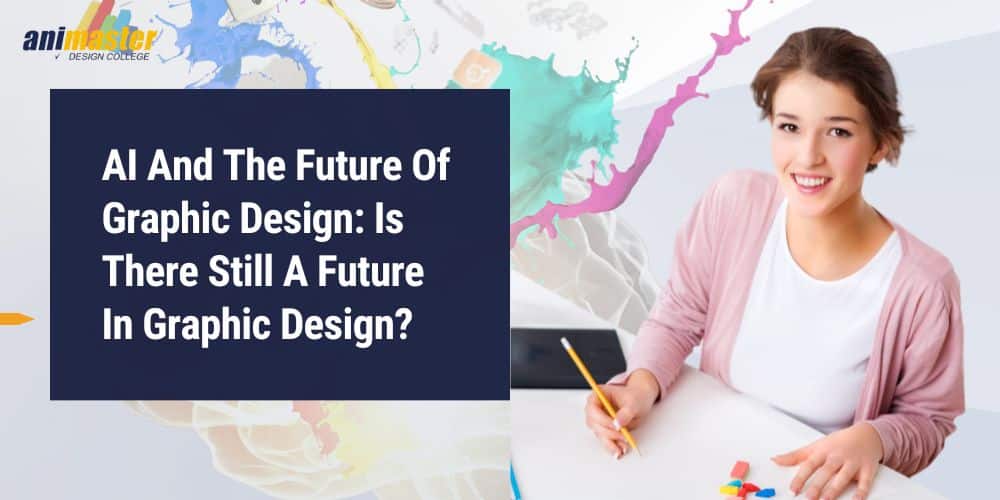
AI And The Future Of Graphic Design: Is There Still A Future In Graphic Design?
The rise of Artificial Intelligence (AI) is causing a paradigm shift in the fast-paced world of graphic design. This makes us wonder about the future of this creative field. This article looks at the complicated relationship between AI and graphic design. It looks at the opportunities, challenges, and effects that could happen in the future. As AI continues to change more and more industries, its effects on graphic design are both exciting and scary. Do you want to know if graphic design a good career for the future. Keep reading below.
The Rise of AI in the Design Industry
In the last few years, AI technology has greatly impacted graphic design. This has changed the creative process in a big way by giving designers access to AI-powered tools that make tasks easier and improve efficiency. Platforms like Canva and Adobe Spark, which use AI algorithms to offer pre-designed templates and automate repetitive tasks, have made design more accessible and made it possible for people without formal design training to make content that looks good. Some design purists see this as a threat to the realness of design, but others see it as a way for more people to be creative.
Is Artificial Intelligence Replacing Humans in the Design Industry?
Before moving on to the next section, it is important to answer the question: Is AI replacing human designers? The idea that AI could completely replace human designers is still complicated. AI is powerful because it can handle huge amounts of data, spot patterns, and create content at a rate that has never been seen before. However, AI lacks the human touch, comprising emotional intelligence, creativity, and intuition. AI does not replace designers; instead, it is a powerful ally that frees them from boring tasks so they can focus on higher-level thinking, developing new ideas, and improving design concepts. The future of design will depend on how well human creativity and AI’s ability to do computations work together.
Here is what to consider if you are looking at Graphic design in the next 10 years
1. Task Automation:
AI is very good at automating boring tasks like resizing images and changing colours, making designers much more productive. Because these features save time, designers have more time to work on higher-level creative projects. This encourages innovation and complex design exploration.
2. Accessibility:
AI’s influence goes beyond making things more efficient; it also makes things easier for people with disabilities to use. AI is making design more inclusive by helping people choose fonts that are easier to read and making audio descriptions for people who cannot see. This is increasing the impact on the design industry.
3. Personalization and custom experiences:
AI allows designers to make experiences for each user based on their preferences and habits. The result is a design journey that takes the audience on a deep dive into their tastes.
4. Ethical Considerations:
The rise of content made by AI sparks important ethical conversations about copyright protection and originality. As AI makes more and more content, designers must figure out how to keep their art’s originality and deal with the ethical issues AI raises for creative ownership.
5. The Human Element:
AI can speed up processes but cannot replace the subtle creativity and empathy that human designers bring to their work. Human designers still have the best emotional connection, cultural understanding, and creative ideas.
The Future of Graphic Design: Career Opportunities
The use of AI in graphic design has changed how designs are made and opened the door to new job opportunities. As AI technology keeps changing, so do the jobs in the design industry. Because of the AI revolution, new jobs are opening up, such as those for creative technologists, AI Design Strategists, and Experience Designers. These jobs’ unique mix of technical and creative skills would be best. This lets professionals use AI tools to develop creative, user-centered design solutions.
Traditional design roles are also changing, along with these more specialized ones. Designers are being asked to work closely with AI systems, giving them direction, creative input, and oversight to ensure that the designs made by AI systems align with the brand’s values and appeal to the target audience. As AI takes over routine tasks, designers are free to focus on strategic thinking, problem solving, and creating experiences that go beyond the limits of technology.
Collaborative Synergy: When human designers and AI-driven tools work well together, it opens the door to new jobs, such as AI Managers, developers, and designers. Collaboration has the potential to lead to groundbreaking innovations and a wide range of new career paths.
Focusing on creativity and strategy: As AI manages routine tasks, designers can focus their energy on creative and strategic projects. This change could lead to designers specializing in making AI-made content look better and ensuring it fits the brand’s goals and values.
Getting creative people to solve problems: Combining human creativity with AI’s ability to solve problems quickly and accurately speeds up creative problem solving. AI is a tool that designers use to explore uncharted territory and come up with creative solutions to hard design problems.
Personalized Design Ecosystem: Because AI’s data analytics and human intuition work well together, designers can make highly personalized and relevant designs. By using AI to get insights, designers can develop solutions that fit each client’s unique vision.
Ethical Design Stewardship: Ethical concerns are becoming more important in the age of artificial intelligence. Designers must deal with the ethical implications of AI-generated content, ensuring their creations are fair, transparent, and real.
Personalization Par Excellence: Contextual Designs
When AI and graphic design came together, it opened the door to a new era of hyper-personalization. AI’s insights, based on data, let designers make content that fits each person’s preferences, behaviours, and situations. For example, AI can look at user data to develop design suggestions that match the look of the brand and the types of people who use it. This level of customization makes users more interested, builds emotional connections, and makes them more loyal to the brand.
However, finding the right balance between personalization based on data and the human touch is hard. AI can determine what users want based on data, but designers add creativity, stories, and emotional resonance to designs. When AI-generated insights and human creativity come together, the result is design experiences that are beautiful to look at and have a lot of meaning and impact.
Ethical Design Stewardship: Navigating AI Responsibly
As the use of AI in graphic design grows, questions of ethics become more important. Designers and people who make AI must work together to ensure that the AI’s content follows ethical rules, respects intellectual property rights and doesn’t keep biases alive. AI systems can unintentionally reflect biases in the data they are trained on, which can lead to results that were not intended.
To find their way through this ethical landscape, designers must be careful when judging AI systems’ content. They need to know how to spot and fix biases so that designs are inclusive and show many different points of view. In addition, the content made by AI must be clear and answerable. Designers should teach clients and users how AI is used in the design process. This will help them understand the technology’s strengths and weaknesses better.
Is a Graphic Design Course Worth It?
Even though AI technologies are becoming more popular, graphic design education is still very important. AI tools can speed up some parts of the design process but cannot replace the depth of creative thinking, ideation, and design principles you learn in school. People who take a complete graphic design course learn a lot about design theory, typography, composition, and visual communication.
A design education also helps students think critically and solve problems, which are important skills for navigating the complex design industry. AI is a powerful tool, but you need to know what you are doing to use it well. Artificial intelligence designer have learned the ins and outs of their craft rather than as a replacement can use AI as a tool.
Animaster is the Best Graphic design College in Bangalore with years of experience. In a field like graphic design that is always changing, AI is a driver of innovation that starts a revolution that pushes the limits of creativity. The future of graphic design depends on how well AI and human designers can work together to make design experiences that are visually appealing, emotionally moving, and morally sound. As AI technologies continue to improve, the design industry is getting ready to move into a future where creativity has no limits and designers can make a bigger impact by combining human creativity with AI. Enroll into best graphic design college in Bangalore and start your journey today.
FAQs
Ques1. How will AI impact the field of graphic design?
Ans: AI will have a great positive impact on graphic designing. It will be helping in task automation, generating creative ideas, and layout designing. Online Graphic Design Courses will help in understanding creativity and efficiency.
Ques2. Will AI replace human graphic designers?
Ans: AI and human graphic designers are just a collaboration. AI can’t replace human graphic designers as humans are more creative, emotionally attached and have more thinking power over AI. This makes graphic design a good career for the future.
Ques 3. How will AI affect the skillset required for graphic designers?
Ans: Graphic design in the next 10 years will be changing very fast. Graphic designers will need to adapt by learning to work with AI tools and understanding data-driven design. Creativity, critical thinking, and the ability to guide AI-generated content will become crucial skills.
Ques 4. Can AI come up with original design concepts?
Ans: AI can generate new designs by learning from vast datasets, but Artificial Intelligence Designer’s creativity is currently limited to combining existing patterns. Truly original concepts still heavily rely on human creativity and the future is secured.



